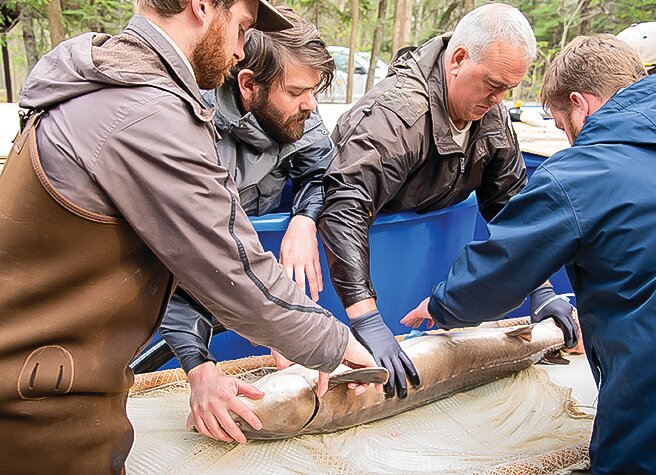Support the Timberjay by making a donation.
DNR now leading egg collection for sturgeon recovery
REGIONAL— Sturgeon eggs from the Minnesota side of the Rainy River will soon be continuing in the effort to restore lake sturgeon populations in the Red River basin in western Minnesota and …
This item is available in full to subscribers.
Attention subscribers
To continue reading, you will need to either log in to your subscriber account, or purchase a new subscription.
If you are a current print subscriber, you can set up a free website account and connect your subscription to it by clicking here.
If you are a digital subscriber with an active, online-only subscription then you already have an account here. Just reset your password if you've not yet logged in to your account on this new site.
Otherwise, click here to view your options for subscribing.
Please log in to continue |
DNR now leading egg collection for sturgeon recovery
REGIONAL— Sturgeon eggs from the Minnesota side of the Rainy River will soon be continuing in the effort to restore lake sturgeon populations in the Red River basin in western Minnesota and eastern North Dakota.
The Minnesota Department of Natural Resources, the U.S. Fish and Wildlife Service, along with the Red Lake and White Earth nations recently completed egg collection from sturgeon in the border river. Those eggs are now being reared at hatcheries in Wisconsin and North Dakota where they will be reared to fingerling size before being released as part of DNR and tribal stocking efforts. In previous years, lake sturgeon eggs were sourced through Rainy River First Nations on the Ontario side of the border.
Sturgeon were historically abundant in Minnesota until the late 1800s, when over-harvesting, dam construction and diminished water quality combined to decimate their population. They were extirpated from the Red River basin by the mid-1900s and there was little chance that the population could recover on its own.
“Stocking efforts and dam modification projects to improve fish passage are key components to support recovery efforts in the Red River basin,” said Matt Skoog, Baudette area fisheries supervisor, who is leading the egg take effort for the DNR.
Discussions that began in the 1980s led to a collaborative sturgeon recovery effort for the basin. DNR lake sturgeon stocking began in 1997 when the DNR relocated sturgeon from the Rainy River to Detroit Lake and Otter Tail rivers, followed by initiation of a 20-year stocking program in conjunction with White Earth and Red Lake nations in 2001 and 2008, respectively.
“Since the early 2000s, the DNR, along with its partners, has stocked more than one-half million lake sturgeon fingerlings in the Red River basin,” said Nick Kludt, DNR Red River fisheries specialist. “Survey results and angler reports suggest that populations are meeting initial recovery goals and lake sturgeon now inhabit much of the basin.”
Sturgeon grow slowly and can live to be more than 150 years old. The Minnesota state record sturgeon was six-and-a-half feet long when caught and released.
The DNR plans to transition management focus away from intensive stocking efforts to monitoring populations in the coming years. During the next phase of restoration, priority will be placed on targeted stocking efforts on rivers within the basin, identifying spawning locations, evaluating the ability of populations to self-sustain and continuing efforts to remove barriers to fish passage.
“With improved connectivity, the maturing sturgeon population will be able to access historic spawning areas and hopefully, reproduce naturally,” Kludt said. “Future dam modifications, along with targeted stocking and population monitoring, will further promote the success of lake sturgeon recovery efforts.”






